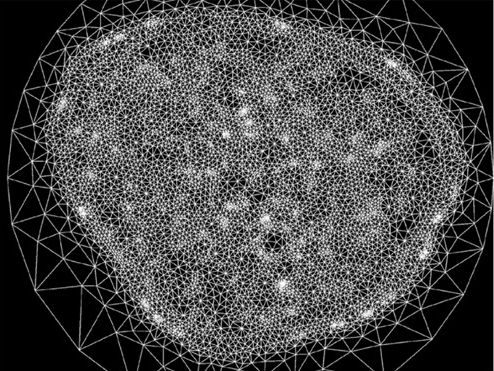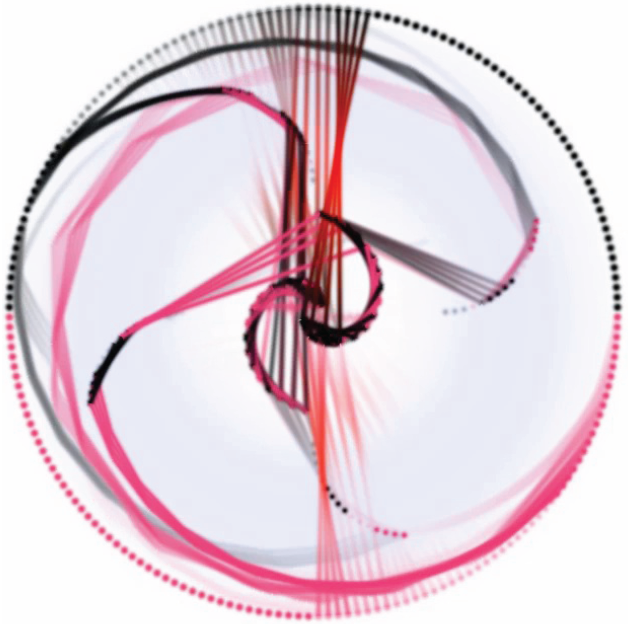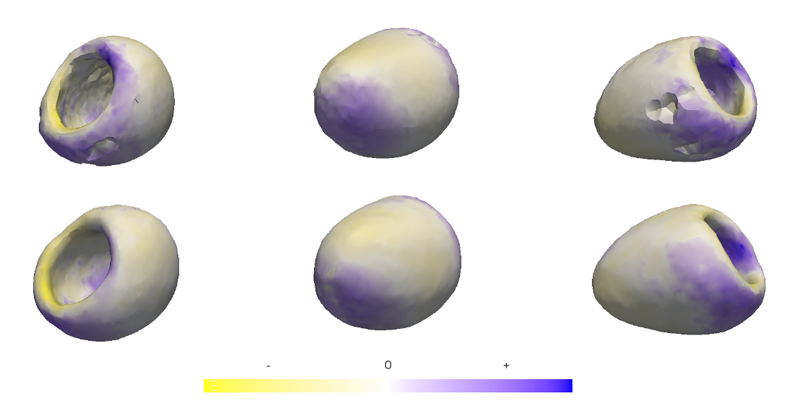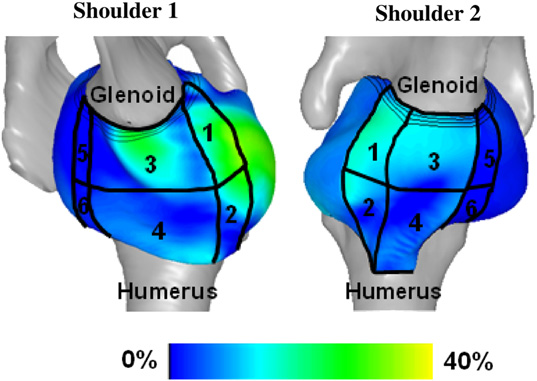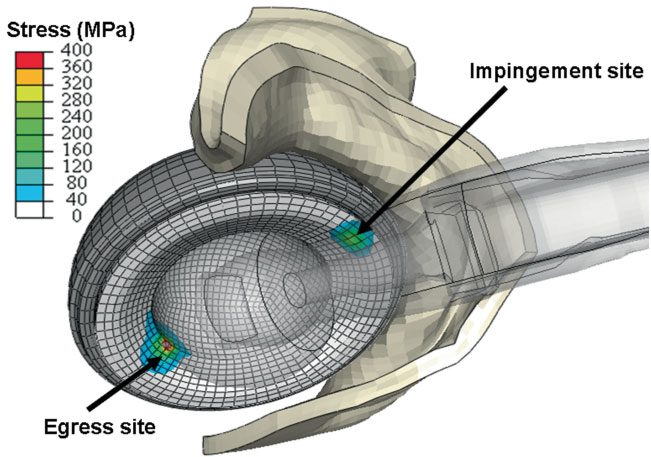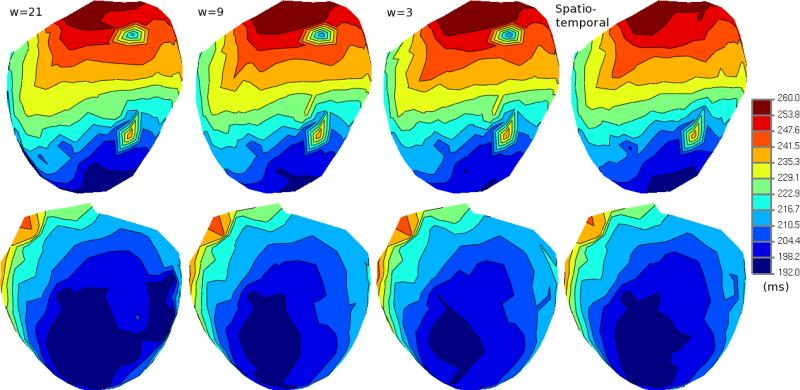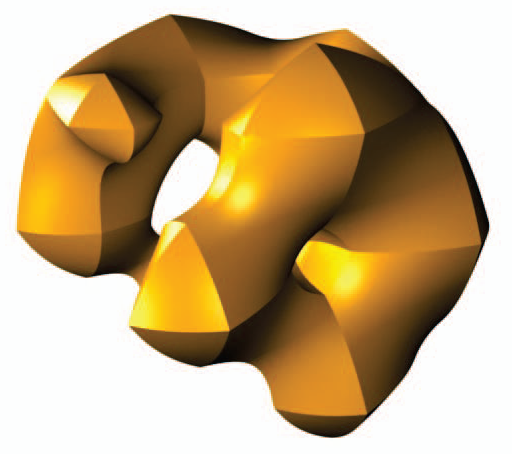SCI Publications
2011


C.R. Butson, I.O. Miller, R.A. Normann, G.A. Clark.
“Selective neural activation in a histologically derived model of peripheral nerve,” In Journal of Neural Engineering, Vol. 8, No. 3, pp. 036009. June, 2011.
ISSN: 1741-2552
DOI: 10.1088/1741-2560/8/3/036009
PubMed ID: 21478574
Functional electrical stimulation (FES) is a general term for therapeutic methods that use electrical stimulation to aid or replace lost ability. For FES systems that communicate with the nervous system, one critical component is the electrode interface through which the machine-body information transfer must occur. In this paper, we examine the influence of inhomogeneous tissue conductivities and positions of nodes of Ranvier on activation of myelinated axons for neuromuscular control as a function of electrode configuration. To evaluate these effects, we developed a high-resolution bioelectric model of a fascicle from a stained cross-section of cat sciatic nerve. The model was constructed by digitizing a fixed specimen of peripheral nerve, extruding the image along the axis of the nerve, and assigning each anatomical component to one of several different tissue types. Electrodes were represented by current sources in monopolar, transverse bipolar, and longitudinal bipolar configurations; neural activation was determined using coupled field-neuron simulations with myelinated axon cable models. We found that the use of an isotropic tissue medium overestimated neural activation thresholds compared with the use of physiologically based, inhomogeneous tissue medium, even after controlling for mean impedance levels. Additionally, the positions of the cathodic sources relative to the nodes of Ranvier had substantial effects on activation, and these effects were modulated by the electrode configuration. Our results indicate that physiologically based tissue properties cause considerable variability in the neural response, and the inclusion of these properties is an important component in accurately predicting activation. The results are used to suggest new electrode designs to enable selective stimulation of small diameter fibers.


G.T. Buzzard, D. Xiu.
“Variance-based Global Sensitivity Analysis via Sparse-grid Interpolation and Cubature,” In Communications in Computational Physics, Vol. 9, No. 3, pp. 542--567. 2011.
DOI: 10.4208/cicp.230909.160310s
The stochastic collocation method using sparse grids has become a popular choice for performing stochastic computations in high dimensional (random) parameter space. In addition to providing highly accurate stochastic solutions, the sparse grid collocation results naturally contain sensitivity information with respect to the input random parameters. In this paper, we use the sparse grid interpolation and cubature methods of Smolyak together with combinatorial analysis to give a computationally efficient method for computing the global sensitivity values of Sobol'. This method allows for approximation of all main effect and total effect values from evaluation of f on a single set of sparse grids. We discuss convergence of this method, apply it to several test cases and compare to existing methods. As a result which may be of independent interest, we recover an explicit formula for evaluating a Lagrange basis interpolating polynomial associated with the Chebyshev extrema. This allows one to manipulate the sparse grid collocation results in a highly efficient manner.
Keywords: Stochastic collocation, sparse grids, sensitivity analysis, Smolyak, Sobol


C.D. Cantwell, S.J. Sherwin, R.M. Kirby, P.H.J. Kelly.
“From h to p Efficiently: Strategy Selection for Operator Evaluation on Hexahedral and Tetrahedral Elements,” In Computers and Fluids, Vol. 43, No. 1, pp. 23--28. 2011.
DOI: 10.1016/j.compfluid.2010.08.012


C.D. Cantwell, S.J. Sherwin, R.M. Kirby, P.H.J. Kelly.
“From h to p Efficiently: Selecting the Optimal Spectral/hp Discretisation in Three Dimensions,” In Mathematical Modelling of Natural Phenomena, Vol. 6, No. 3, pp. 84--96. 2011.


G. Chen, D. Palke, Z. Lin, H. Yeh, P. Vincent, R.S. Laramee, E. Zhang.
“Asymmetric Tensor Field Visualization for Surfaces,” In IEEE Transactions on Visualization and Computer Graphics, Vol. 17, No. 12, IEEE, pp. 1979-1988. Dec, 2011.
DOI: 10.1109/tvcg.2011.170


Guoning Chen, Qingqing Deng, Andrzej Szymczak, Robert S. Laramee, and Eugene Zhang.
“Morse Set Classification and Hierarchical Refinement using Conley Index,” In IEEE Transactions on Visualization and Computer Graphics (TVCG), Vol. 18, No. 5, pp. 767--782. June, 2011.
DOI: 10.1109/TVCG.2011.107
PubMed ID: 21690641
Morse decomposition provides a numerically stable topological representation of vector fields that is crucial for their rigorous interpretation. However, Morse decomposition is not unique, and its granularity directly impacts its computational cost. In this paper, we propose an automatic refinement scheme to construct the Morse Connection Graph (MCG) of a given vector field in a hierarchical fashion. Our framework allows a Morse set to be refined through a local update of the flow combinatorialization graph, as well as the connection regions between Morse sets. The computation is fast because the most expensive computation is concentrated on a small portion of the domain. Furthermore, the present work allows the generation of a topologically consistent hierarchy of MCGs, which cannot be obtained using a global method. The classification of the extracted Morse sets is a crucial step for the construction of the MCG, for which the Poincaré index is inadequate. We make use of an upper bound for the Conley index, provided by the Betti numbers of an index pair for a translation along the flow, to classify the Morse sets. This upper bound is sufficiently accurate for Morse set classification and provides supportive information for the automatic refinement process. An improved visualization technique for MCG is developed to incorporate the Conley indices. Finally, we apply the proposed techniques to a number of synthetic and real-world simulation data to demonstrate their utility.


A.N.M. Imroz Choudhury, P. Rosen.
“Abstract Visualization of Runtime Memory Behavior,” In 6th IEEE International Workshop on Visualizing Software for Understanding and Analysis (VISSOFT 2011), pp. 22--29. 2011.
We present a system for visualizing memory reference traces, the records of the memory transactions performed by a program at runtime. The visualization consists of a structured layout representing the levels of a cache and a set of data glyphs representing the pieces of data in memory being operated on during application runtime. The data glyphs move in response to events generated by a cache simulator, indicating their changing residency in the various levels of the memory hierarchy. Within the levels, the glyphs arrange themselves into higher-order shapes representing the structure of the cache levels, including the composition of their associative cache sets and eviction ordering. We make careful use of different visual channels, including structure, motion, color, and size, to convey salient events as they occur. Our abstract visualization provides a high-level, global view of memory behavior, while giving insight about important events that may help students or software engineers to better understand their software’s performance and behavior.


A. Cuadros-Vargas, L.G. Nonato, V. Pascucci.
“Combinatorial Laplacian Image Cloning,” In Proceedings of XXIV Sibgrapi – Conference on Graphics, Patterns and Images, pp. 236--241. 2011.
DOI: 10.1109/SIBGRAPI.2011.7
Seamless image cloning has become one of the most important editing operation for photomontage. Recent coordinate-based methods have lessened considerably the computational cost of image cloning, thus enabling interactive applications. However, those techniques still bear severe limitations as to concavities and dynamic shape deformation. In this paper we present novel methodology for image cloning that turns out to be highly efficient in terms of computational times while still being more flexible than existing techniques. Our approach builds on combinatorial Laplacian and fast Cholesky factorization to ensure interactive image manipulation, handling holes, concavities, and dynamic deformations during the cloning process. The provided experimental results show that the proposed technique outperforms existing methods in requisites such as accuracy and flexibility.


M. Daccarett, T.J. Badger, N. Akoum, N.S. Burgon, C. Mahnkopf, G.R. Vergara, E.G. Kholmovski, C.J. McGann, D.L. Parker, J. Brachmann, R.S. Macleod, N.F. Marrouche.
“Association of left atrial fibrosis detected by delayed-enhancement magnetic resonance imaging and the risk of stroke in patients with atrial fibrillation,” In Journal of the American College of Cardiology, Vol. 57, No. 7, pp. 831--838. 2011.
PubMed ID: 21310320


M. Daccarett, C.J. McGann, N.W. Akoum, R.S. MacLeod, N.F. Marrouche.
“MRI of the left atrium: predicting clinical outcomes in patients with atrial fibrillation,” In Expert Review of Cardiovascular Therapy, Vol. 9, No. 1, pp. 105--111. 2011.
PubMed ID: 21166532


M. Datar, Y. Gur, B. Paniagua, M. Styner, R.T. Whitaker.
“Geometric Correspondence for Ensembles of Nonregular Shapes,” In Proceedings of Medical Image Computing and Computer-Assisted Intervention (MICCAI 2011), Lecture Notes in Computer Science (LNCS), Vol. 6892, pp. 368--375. 2011.
DOI: 10.1007/978-3-642-23629-7_45
PubMed ID: 21995050
PubMed Central ID: PMC3346950
An ensemble of biological shapes can be represented and analyzed with a dense set of point correspondences. In previous work, optimal point placement was determined by optimizing an information theoretic criterion that depends on relative spatial locations on different shapes combined with pairwise Euclidean distances between nearby points on the same shape. These choices have prevented such methods from effectively characterizing shapes with complex geometry such as thin or highly curved features. This paper extends previous methods for automatic shape correspondence by taking into account the underlying geometry of individual shapes. This is done by replacing the Euclidean distance for intrashape pairwise particle interactions by the geodesic distance. A novel set of numerical techniques for fast distance computations on curved surfaces is used to extract these distances. In addition, we introduce an intershape penalty term that incorporates surface normal information to achieve better particle correspondences near sharp features. Finally, we demonstrate this new method on synthetic and biological datasets.
Keywords: namic


N.J. Drury, B.J. Ellis, J.A. Weiss, P.J. McMahon, R.E. Debski.
“Finding consistent strain distributions in the glenohumeral capsule between two subjects: Implications for development of physical examinations,” In Journal of Biomechanics, Vol. 44, No. 4, pp. 607-613. February, 2011.
DOI: 10.1016/j.jbiomech.2010.11.018
The anterior-inferior glenohumeral capsule is the primary passive stabilizer to the glenohumeral joint during anterior dislocation. Physical examinations following dislocation are crucial for proper diagnosis of capsule pathology; however,they are not standardized for joint position which may lead to misdiagnoses and poor outcomes. To suggest joint positions for physical examinations where the stability provided by the capsule may be consistent among patients, the objective of this study was to evaluate the distribution of maximum principal strain on the anterior-inferior capsule using two validated subject-specific finite element models of the glenohumeral joint at clinically relevant joint positions. The joint positions with 25 N anterior load applied at 60° of glenohumeral abduction and 10°, 20°, 30° and 40° of external rotation resulted in distributions of strain that were similar between shoulders(r2≥0.7). Furthermore, those positions with 20-40° of external rotation resulted in capsule strains on the glenoid side of the anterior band of the inferior glenohumeral ligament that were significantly greater than in all other capsule regions. These findings suggest that anterior stability provided by the anterior-inferior capsule may be consistent among subjects at joint positions with 60° of glenohumeral abduction and a mid-range (20-40°) of external rotation, and that the glenoid side has the greatest contribution to stability at these joint positions. Therefore, it may be possible to establish standard joint positions for physical examinations that clinicians can use to effectively diagnose pathology in the anterior-inferior capsule following dislocation and lead to improved outcomes.


S. Durrleman, M.W. Prastawa, G. Gerig, S. Joshi.
“Optimal data-driven sparse parameterization of diffeomorphisms for population analysis,” In Proceedings of the IPMI 2011 conference, Springer LNCS, Vol. 6801/2011, pp. 123--134. July, 2011.
DOI: 10.1007/978-3-642-22092-0_11
PubMed ID: 20516153


S. Durrleman, X. Pennec, A. Trouvé, N. Ayache, J. Braga.
“Comparison of the endocranial ontogenies between chimpanzees and bonobos via temporal regression and spatiotemporal registration,” In Journal of Human Evolution, pp. 74--88. January, 2011.
DOI: 10.1016/j.jhevol.2011.10.004
PubMed ID: 22137587
This paper aims at quantifying ontogenetic differences between bonobo (Pan paniscus) and chimpanzee (Pan troglodytes) endocrania, using dental development as a timeline. We utilize a methodology based on smooth and invertible deformations combined with a metric of "currents" that defines a distance between endocranial surfaces and does not rely on correspondence between landmarks. This allows us to perform a temporal surface regression that estimates typical endocranial ontogenetic trajectories separately for bonobos and chimpanzees. We highlight non-linear patterns of endocranial ontogenetic change and significant differences between species at local anatomical levels rather than considering the endocranium as a uniform entity. A spatiotemporal registration permits the quantification of inter-species differences decomposed into a morphological deformation (accounting for size and shape differences independently of age) and a time warp (accounting for changes in the dynamics of development). Our statistical simulations suggest that patterns of endocranial volume (EV) increase may differ significantly between bonobos and chimpanzees, with an earlier phase of a relatively rapid increase (preferentially at some endocranial subdivisions) in the former and a much later phase of relatively rapid increase in the latter. As a consequence, the chimpanzee endocranium appears to reach its adult size later. Moreover, the time warp indicates that juvenile bonobos develop much slower than juvenile chimpanzees, suggesting that inter-specific ontogenetic shifts do not only concern EV increase, but also the rate of shape changes over time. Our method provides, for the first time, a quantitative estimation of inter-specific ontogenetic shifts that appear to differentiate non-linearly.


M. Edmunds, T. McLoughlin, R.S. Laramee, G. Chen, E. Zhang, N. Max.
“Automatic Stream Surface Seeding,” In EUROGRAPHICS 2011 Short Papers, pp. 53--56. 2011.


J.M. Elkins, J.S. Stroud, M.J. Rudert, Y. Tochigi, D.R. Pedersen, B.J. Ellis, J.J. Callaghan, J.A. Weiss, T.D. Brown.
“The capsule's contribution to total hip construct stability - a finite element analysis,” In Journal of Orthopedic Research, Vol. 29, No. 11, Note: William Harris, MD Award, pp. 1642--1648. November, 2011.
DOI: 10.1002/jor.21435
Instability is a significant concern in total hip arthroplasty (THA), particularly when there is structural compromise of the capsule due to pre-existing pathology or due to necessities of surgical approach. An experimentally grounded fiber-direction-based finite element model of the hip capsule was developed, and was integrated with an established three-dimensional model of impingement/dislocation. Model validity was established by close similarity to results from a cadaveric experiment in a servohydraulic hip simulator. Parametric computational runs explored effects of graded levels of capsule thickness, of regional detachment from the capsule's femoral or acetabular insertions, of surgical incisions of capsule substance, and of capsule defect repairs. Depending strongly upon the specific site, localized capsule defects caused varying degrees of construct stability compromise, with several specific situations involving over 60\% decrement in dislocation resistance. Construct stability was returned substantially toward intact-capsule levels following well-conceived repairs, although the suture sites involved were often at substantial risk of failure. These parametric model results underscore the importance of retaining or robustly repairing capsular structures in THA, in order to maximize overall construct stability. © 2011 Orthopaedic Research Society. Published by Wiley Periodicals, Inc. J Orthop Res 29:1642–1648, 2011


B.J. Ellis.
“Finite element modeling of knee and shoulder ligaments,” Note: Ph.D. Thesis, Department of Bioengineering, University of Utah, 2011.


B. Erem, D.H. Brooks, P.M. van Dam, J.G. Stinstra, R.S. MacLeod.
“Spatiotemporal Estimation of Activation Times of Fractionated ECGs on Complex Heart Surfaces,” In Proceedings of the International Coference of the IEEE Engineering in Medicine and Biology Society (EMBS), pp. 5884--5887. 2011.
DOI: 10.1109/IEMBS.2011.6091455
PubMed ID: 22255678
PubMed Central ID: PMC3345888
Identification of electrical activation or depolarization times on sparsely-sampled complex heart surfaces is of importance to clinicians and researchers in cardiac electrophysiology. We introduce a spatiotemporal approach for activation time estimation which combines prior results using spatial and temporal methods with our own progress on gradient estimation on triangulated surfaces. Results of the method applied to simulated and canine heart data suggest that improvements are possible using this novel combined approach.


T. Etiene, L.G. Nonato, C. Scheidegger, J. Tierny, T.J. Peters, V. Pascucci, R.M. Kirby, C.T. Silva.
“Topology Verfication for Isosurface Extraction,” In IEEE Transactions on Visualization and Computer Graphics, pp. (accepted). 2011.
The broad goals of verifiable visualization rely on correct algorithmic implementations. We extend a framework for verification of isosurfacing implementations to check topological properties. Specifically, we use stratified Morse theory and digital topology to design algorithms which verify topological invariants. Our extended framework reveals unexpected behavior and coding mistakes in popular publicly-available isosurface codes.


J. Fishbaugh, S. Durrleman, G. Gerig.
“Estimation of Smooth Growth Trajectories with Controlled Acceleration from Time Series Shape Data,” In Lecture Notes in Computer Science, LNCS 6892, Springer, pp. 401--408. 2011.
DOI: 10.1007/978-3-642-23629-7_49
Longitudinal shape analysis often relies on the estimation of a realistic continuous growth scenario from data sparsely distributed in time. In this paper, we propose a new type of growth model parameterized by acceleration, whereas standard methods typically control the velocity. This mimics the behavior of biological tissue as a mechanical system driven by external forces. The growth trajectories are estimated as smooth flows of deformations, which are twice differentiable. This differs from piecewise geodesic regression, for which the velocity may be discontinuous. We evaluate our approach on a set of anatomical structures of the same subject, scanned 16 times between 4 and 8 years of age. We show our acceleration based method estimates smooth growth, demonstrating improved regularity compared to piecewise geodesic regression. Leave-several-out experiments show that our method is robust to missing observations, as well as being less sensitive to noise, and is therefore more likely to capture the underlying biological growth.
Keywords: na-mic





